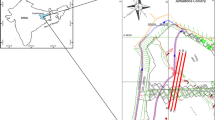Abstract
Land subsidence is a serious problem in Indian coalfields due to old underground mine workings. Unfortunately, most of these are uncharted as no mine plans are available. The hidden galleries, goafs, shafts etc. may pose great threat for future mine development as well as to the local environment. The mine workings should be charted to undertake an effective preventive action. In the present study, 2D electrical resistivity tomography (ERT) technique has been used to detect underground mine workings, mainly air or water filled galleries. Initially, the whole exercise has been executed through a synthetic model study. Gaussian random noise of 5mV/A has been added with synthetic data to demonstrate field condition which provides realistic results. ERT survey was conducted over a part of Jogidih coal mine of Jharia coal field in India for a first time. Four electrode configurations, Wenner, Schlumberger, dipole-dipole and gradient were considered for this study. The results indicate the presence of sub-surface water and air filled cavity due to high resistivity contrast with surroundings.
Similar content being viewed by others
References
Bharti A.K., Pal, S.K., Priyam P., Narayan S., Pathak, V. K.and Sahoo, S.D. (2015) Detection of Illegal Mining over Raniganj Coalfield using Electrical Resistivity Tomography. Spec. Publ., Jour. Eng. Geol., pp.65–69.
Bharti, A.K., Pal, S.K., Priam, P., Kumar, S., Shalivahan and Yadav, P.K. (2016) Subsurface cavity detection over Patherdih colliery, Jharia Coalfield, India using electrical resistivity tomography. Environ. Earth Sci., v.75(5), p.443. DOI 10.1007/s12665-015-5025-z.
Chandra, D. (1992) Jharia Coalfields, Geological Society of India, Bangalore, 149p.
Chandra, D. and Chakraborty, N.C. (1989) Coalification trends in Indian coals. Internat. Jour. Coal Geol., v.13, pp.413–435.
Dahlin, T. and Zhou, B. (2004) A numerical comparison of 2D resistivity imaging with 10 electrode arrays. Geophys. Prospect., v.52, pp.379–398, doi:10.1111/j.1365-2478.2004.00423.x.
Dahlin, T. and Zhou, B. (2006) Multiple-gradient array measurements for multichannel 2D resistivity imaging. Near Surface Geophysics, v.4, pp.113–123.
Dobecki, T.L. and Upchurch, S.B. (2006) Geophysical application to detect sinkhole and ground subsidence. Lead. EDGE, v.25, pp.336–341.
Edwards, L.S. (1977) A modified pseudosection for resistivity and inducedpolarization. Geophysics, v.42, pp.1020–1036.
Ezersky, M. (2008) Geoelectric structure of the Ein Gedi sinkhole occurrence site at the Dead Sea shore in Israel. Jour. Appld Geophys., v.64, pp.56–69, doi: 10.1016/j/jappgeo.12.003.
Griffiths, D.H. and Barker, R.D. (1993) Two-dimensional resistivity imaging and modelling in areas of complex geology, Jour. Appld. Geophys., v.29, pp.211–226, doi:10.1016/0926-9851(93) 90005J.
GSI (1964) Mem. Geol. Surv. India, v.84, plate 6.
Krishnamurthy, N.S., Rao, V. Ananda, Kumar Dewashish, Singh, K.K.K. and Ahmed, S. (2009) Electrical Resistivity Imaging Technique to delineate coal seam barrier thickness and demarcate water filled voids. Geol. Soc. India, v.73, pp.639–650.
Kruse, S.M. Grasmueck, M. Weiss and Viggiano, D. (2006) Sinkhole structure imaging in covered karst terrain. Geophysical Res. Lett., v.33, L16405, doi: 10.1029/2006GL026975
Leucci, G., Margiotta, S. and Negri, S. (2004) Geophysical and Geological Investigations in a Karstic Environment. Jour. Environ. Engg. Geophys., v.9, pp.25–34.
Loke, M. and Barker, R. (1996) Rapid least-squares inversion of apparent resistivity pseudosection by a quasi-Newton method. Geophys. Prospect., v.44, pp.131–152.
Loke, M.H., Acworth, I. and Dahlin, T. (2003) A comparison of smooth and blocky inversion methods in 2D electrical imaging surveys. Explo. Geophys., v.34, pp.182–187.
Loke M.H. (1999) Electrical imaging surveys for environmental and engineering studies a practical guide to 2-D and 3-D surveys, 63p.
Maillol, J.M., Seguin, M.K., Gupta, O.P., Akhauri, H.M. and Sen, N. (1999) Electrical resistivity tomography survey for delineating uncharted mine galleries in West Bengal, India. Geophys. Prospect., v.47, pp.103–116. doi:10.1046/j.1365-2478.1999.00126.x.
Martinez, J., Benavente, J., Garcia-Aro stegui, J.L., Hidalgo, M.C. and Rey, J. (2009) Contribution of electrical resistivity tomography to the study of detrital aquifers affected by seawater intrusion-extrusion effects: The River Velez delta (Velez-Malaga, southern Spain). Engg. Geol., v.108, pp.161–168. doi:10.1016/j.enggeo.2009.07.004.
Pal, S.K., Vaish, J., Kumar, S. and Bharti, A.K. (2016) Coalfire mapping of East Basuria Colliery, Jharia coal field using Vertical Derivative Technique of Magnetic data, Jour. Earth System Sci., v.125(1), pp.165–178.
Srivardhan V., Pal S. K., Vaish, J., Kumar, S., Bharti, A. and Priyam, P. (2016) Particle swarm optimization inversion of self-potential data for depth estimation of coal fires over East Basuria colliery, Jharia coalfield, India. Environ. Earth Sci., v.75(8), pp.1–12.
Stummer, P., Maurer, H. and Green, A. (2004) Experimental design Electrical resistivity data sets that provide optimum subsurface information. Geophys., v.69 (1), pp.120–139.
Singh, K.K.K. (2013a) MineVue radar for delineation of faults in underground coal mines of India. Curr. Sci., v.105(12), pp.668–1670.
Singh, K.K.K. (2013b) Delineation of waterlogged area in inaccessible underground workings at Hingir Rampur Colliery using 2D resistivity imaging: a case study. Bull. Engg. Geol. Environ., v.72(1), pp.115–118.
Singh, K.K.K. (2003) Ground Penetrating Radar study for hydrogeological conditions related with mining activity. Environ. Geol., v.44, pp.20–27.
Vaish, J. and Pal, S.K. (2015) Subsurface coal fire mapping of East Basuria Colliery, Jharkhand. Jour. Geol. Soc. India, v.86(4), pp.438–444.
Vaish, J. and Pal, S.K. (2016) Subsurface Coal fire mapping of Patherdih Colliery, a part of Jharia coal field, India. Geol. Soc. India, Spec. Publ., no.4, pp.80–85. DOI: 10.17491/cgsi/2016/95899.
Van Schoor, M. (2002) Detecting of sinkholes using 2D electrical resistivity imaging. Jour. Appld. Geophys.,v.50, pp.393–399. doi:10.1016/S0926-9851(02)00166-0.
Verma, R.K. and Bhuin, N.C. (1979) Use of Electrical Resistivity Methods for study of coal seams in parts of the Jharia Coalfields, India. Geoexploration v.17, pp.163–176
Zhou, W., Beck, B.F. and Stephenson, J.B. (2000) Reliability of dipole-dipole electrical resistivity tomography for depth of bedrock in covered karst terranes. Environ. Geol., v.39, pp.760–766. doi:10.1007/s002540050491
Zhou, W., Beck, B.F. and Adams, A.L. (2002) Effective electrode array in mapping karst hazards in electrical resistivity tomography. Environ. Geol., v.42, pp.922–928.
Author information
Authors and Affiliations
Corresponding author
Rights and permissions
About this article
Cite this article
Das, P., Pal, S.K., Mohanty, P.R. et al. Abandoned mine galleries detection using electrical resistivity tomography method over Jharia coal field, India. J Geol Soc India 90, 169–174 (2017). https://doi.org/10.1007/s12594-017-0695-7
Received:
Accepted:
Published:
Issue Date:
DOI: https://doi.org/10.1007/s12594-017-0695-7




